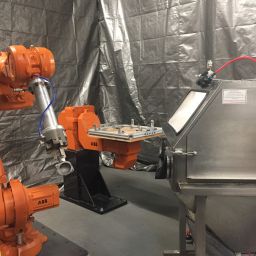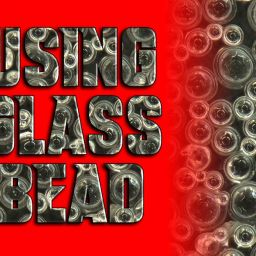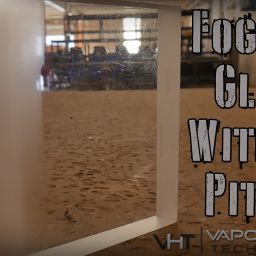Surface Preparation 101: How to Prepare a Surface for Blasting
Do you have used parts, new parts , or vintage parts in need of a facelift? If your answer is yes then your first step is to clean and prepare them for blasting.
Proper surface preparation will ensure your protective coating will adhere to the surface and last for a long time. Preparing a surface removes the following, dirt, grime, grease, paint, and other contaminants that can negatively affect your protective coating.
One of the most effective ways to prepare a surface is with vapor blasting. First is vapor blasting removes old paint and debris, leaving the surface clean. The surface finish has a slight texture making it easy for paint and sealants to adhere to the surface.
The biggest challenge is to properly prepare the surface you’re blasting. Different materials require different types of blasting and abrasives. If you choose the wrong one, you can end up damaging the material or choose too weak of an abrasive therefore will not prepare the surface for the coating being applied.
Here’s everything you need to know about surface preparation and how to prepare a surface for blasting.
Surface Preparation Standards
Did you know there are surface preparation standards you should follow to ensure the longevity of your protective coating? The reason behind them is to offer you maximum coating life while reducing costs. Surface preparation accounts for just under half of the time and cost of a painting project.
Surface preparation refers to preparing a surface, whether it be metal, wood, fiberglass, or concrete, for a protective coating. The preparation involves cleaning and removing debris and grime from the material surface. It also includes finishing the surface with a slight texture to ensure the coating adheres to the material’s surface.
There are two types of abrasive blast standards for cleaning. Both have similar levels of cleanliness but differ in how they classify cleaning.
ISO 8501
Published in 1988, this standard is a pictorial standard guide completed by the International Standards Organization. It focuses on different levels of rust grades at varying levels of cleanliness. The images have some written descriptions accompanying the images.
This standard ranks steel and other hard alloys in order of cleanliness, based on the increasing work required. The levels include:
- First- Sa 1 Light Blast Cleaning
- Second- Sa 2 Thorough Blast Cleaning
- Third- Sa 3 Blast Cleaning to Visually Clean Steel
The protective coating you choose will help you decide which of the above ISO 8501 rankings will best suit your needs.
SSPC/NACE
This standard began in the 1960s with standards set by an American architectural group for Pittsburgh steelworkers. Eventually, the Society for Steel Painting Structures adopted these standards.
Today, the SSPC / NACE standards are text descriptions of different levels of cleanliness. They’re rated in reverse order by increasing the level of surface cleanliness. While this standard is text-focused, images and photos accompany the descriptions.
The levels go like this:
- First- SP 5 White Metal (the cleanest metal)
- Second- SP 6 Commercial
- Third- SP 7 Brush Off (the least clean)
The details of each surface preparation standard include stains, shadows, streaks, and other contaminants. Both standards are compatible in terms of levels of cleanliness based on trains, discoloration, and mill scale.
Most businesses preparing a surface for a protective coating will weigh the cost of prepping and painting against the risk of a failing coating. If a coating failure could be catastrophic, you’ll want to prep your surface to be as clean as possible. For most, Commercial or Near White levels of cleanliness work well.
Common Surface Preparation Terms
In addition, there are several steps in the process of preparing a surface for blasting and coating. Common words you’ll hear include the following, cleaning, degreasing, and surface profile. But what do these mean?
Degreasing
Degreasing refers to removing oils or grease-like materials from the substrate. Grease, both organic and non-organic can and will prevent protective coatings and paint from properly adhering to the material’s surface. Grease is common in machinery and parts used in a variety of industries.
You can degrease the surface using a degreasing chemical such as a solvent. These include ammonia, bleach, citric acid, or any solvent that will react and remove grease and oil. If you go this route, make sure you rinse and remove any residue from the solvent as it can affect the protective coat.
Vapor blasting is a faster and easier method of degreasing a surface. As it cleans the surface it will also remove grease and other oily contaminants.
Cleaning
Cleaning the surface is the process of removing all debris and contaminants, including grease. You can manually wipe these away using a vacuum for loose debris and cleaning solutions.
A much faster and efficient way to clean the substrate is with vapor blasting. Blasting removes everything from grease and oils to loose debris such as dirt and dust.
Profile
The cleaned and finished surface needs a texture for the protective coating to adhere to the substrate. The creation of this texture is the profile. You can create a textured profile by grinding the surface or blasting it with dry or wet abrasive media.
The preferred methods of creating a profile include:
- Shot blasting
- Aggregate blasting
- Roto peening
- Abrasive wheel grinding
- Silica sand blasting
- Soft media blasting
With vapor blasting, you can choose the right abrasive for the substrate being blasted and the surface preparation standard needed. We’ll dig into the types of abrasives a little later on.
Surface Preparation Before Vapor Blasting
There are many ways you can prepare a surface such as manually grinding, scraping, and sanding. Even with a grinder or sander, these methods are very time consuming and don’t always guarantee an even finish. Preparing small complex surfaces will be difficult while large surfaces will take a lot of time and energy.
Fortunately, there’s a much easier way.
Vapor blasting, also known and vapor honing, is one of the most effective and safest surface preparation solutions. Other than selecting the right abrasive and the right size machine to blast, you don’t need to prepare the surface of the substrate. The abrasive blasting will remove everything including oils, grease, old paint, oxidation, and any other contaminants.
Vapor blasting uses a mix of water and abrasive material to strip away the contaminants marring the substrate. This blasting mix is the slurry. It works well cleaning and finishing all surfaces of all sizes, complexities, and materials.
The first step in the blasting process is identifying the type of material you’re preparing. Soft and sensitive materials will need a softer abrasive media compared to harder surfaces. The material will also determine the best pressure to use for vapor blasting.
Picking the Right Abrasive Material
Abrasive materials for vapor blasting come in a variety of sizes, materials, and shapes. The shape and size of the abrasive along with the air pressure ejecting the abrasive will determine the finish and profile outcome.
Do you want a rougher finish? Use an abrasive material with more angular and larger particles.
Do you prefer a finer finish? There are abrasive materials that are rounder, smoother, and smaller. They’ll create a finer texture that’s safe for soft metals and sensitive materials.
Here’s a breakdown of the common abrasive media from most to least abrasive.
Silicon carbide
Silicon carbide is one of the hardest and most abrasive available blasting material. This abrasive is best for challenging surfaces with significant oxidation or contaminant buildup. You can find it in a variety of purities and colors.
Common uses include polishing, lapping, glass etching, and heavy-duty blast cutting.
Aluminum Oxide Grit
This media is significantly hard and strong and also has increased wear resistance during the blasting process. Its uses range from creating anti-slip surfaces to surface preparation for protective coatings.
Starblast
This general blasting abrasive is a mix of fine and coarse staurolite stand. It consists of extremely low levels of silica and great for removing corrosion and scale from steel substrates.
Crushed Glass
This eco-friendly abrasive comes from recycled glass and is completely free of silica. It’s a cost-effective option that’s efficient for stripping applications.
Glass Beads
Glass beads are not an aggressive blasting media. It’s a great option for those looking for a softer and brighter surface finish and a great choice for most materials include stainless steel. The glass is recyclable making it cost-effective and eco-friendly.
Stainless Steel Shot and Grit
Steel grit is a great abrasive is a cost-effective abrasive that’s tough and highly recyclable. The level of abrasion depends on the size and shape of the steel grit. This is a great option for cleaning, finishing, and peening a wide range of materials.
Walnut Shell
Made from crushed walnut shells, this abrasive is one of the harder soft abrasives available. It comes in several different sizes and shapes for polishing and cleaning softer surfaces. It’s a great choice for those needing to finish fiberglass, plastics, wood, stone, and soft metals. However, this abrasive does not run or work well in a vapor honing machine and can only be used in dry blasting equipment.
Plastic abrasive
This soft abrasive comes in a range of sizes and shapes made from acrylic, urea, or polyester. Plastic abrasives are great for cleaning molds, plastic parts, or any material where you can’t risk removing the substrate. The aviation, automotive, boating, and electronics industries commonly use plastic abrasive.
All of these materials are safe for dry and vapor blasting techniques. You can further adjust the level of abrasion by lowing or raising the PSI of the compressor during the blasting process.
The Vapor Blasting Process
Vapor blasting is a mix of abrasive material and water propelled at a substrate using compressed air. Depending on your component size helps determine which size of machine you need. Also, will this be a machine that’s used daily or a few times a week will also help you determine which machine fits your application.
All Vapor Honing systems mix the water and the abrasive being used into a hopper and then a slurry pumping system sends this slurry to a blasting gun. This is most commonly found in indoor vapor honing cabinets. You can, however, use this process outdoors as well.
If you’re working indoors on smaller items, you can use a blast cabinet to contain the blasting process. These will blast the slurry mix onto the blasting item. This is a good choice for cleaning and stripping small automotive and engineering parts.
For best results, test a small hidden area of the substrate you intend to blast. This way you can dial in the air compression to ensure you get the perfect finish without ruining the substrate.
When you find the right air compression and abrasive, vapor blast the rest of the object to the desired level of cleanliness. This will return the substrate to its raw state. Metals will need a protective coating to prevent oxidation and rust. In a vapor honing system there are specific rust inhibitors that can be added into the blasting machine to inhibit rust for a period of time but not indefinitely.
Check the protective coating you plan to use to ensure you reach the proper cleaning and finishing level.
Surface Preparation After Vapor Blasting
The benefit of vapor blasting over dry blasting is the water automatically clears the substrate of the abrasive material. With dry blasting, there’s a chance dry abrasive particles may lodge themselves into the substrate. This will require additional cleaning and rinsing after blasting.
After blasting, allow the substrate adequate time to dry. Compressed air can be used to remove the majority of moisture from the parts being treated or in industrial applications of higher volume heated air may be added to accelerate drying.
Once dried, the surface of the substrate will be ready for coating or painting.
Proper Surface Preparation for Long-lasting Products!
Do you want your parts, products, and machinery to last? Proper surface preparation with vapor blasting will guarantee longevity and quality adhesion of any protective coating you add.
Have questions about what vapor blasting can do for you and your business? Let us know and we’ll help you find the perfect vapor honing machine to match your needs!








